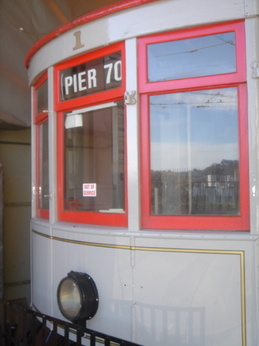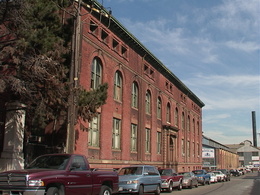The Monday Chronicle lays out an impressive potential future for Pier 70 on the Central Waterfront. What the article describes (accurately) as “the most intact 19th century industrial complex west of the Mississippi River” is being pitched by the city as a new and very attractive home for high-tech businesses. Mayor Newsom calls the 69-acre bayside site “an extraordinary asset that is vastly underappreciated.”

We think so too. That’s why we have consistently advocated Pier 70 as the ultimate terminal for the future E-Embarcadero line (with Muni agreeing to at least keep the option open by including it on vintage streetcar roll signs).
It wouldn’t happen right away, mind you. First off, Muni needs to start up the initial operation of the E-line from Fourth and King to Fisherman’s Wharf. Everything needed to do that is ready, except enough streetcars, which should be ready by the end of 2011. Second, Muni must complete the streetcar terminal loop on Third, 18th, Illinois, and 19th Streets.
As you can see in the Google Earth view below, which looks southeast (click to enlarge), the expensive parts — the switches and crossings on Third Street — are already done, along with most of the track on 18th (at left) and 19th (at right) Streets. Only the curves onto and off of Illinois, along with the block of track on Illinois itself, need to be installed.
A protracted dispute with the Port of San Francisco, which wanted Muni to pay a million dollars in exchange for the right to take over that abandoned freight track on Illinois that would never be used again anyway (true story, but for another time), has kept the loop uncompleted to date.
When completed, this track loop is intended in part as a possible terminal for LRVs to use after the Central Subway opens, either for subway line short turns, or for extending one of the Market Street Subway lines down The Embarcadero and the T-line right-of-way to provide extra service to Mission Bay, should demand grow to the point where that’s needed.
But the loop could be also be used by E-line streetcars, which would then provide single-car direct service that connects virtually every major waterfront attraction in the northern half of the city: Pier 70, Mission Bay, China Basin, AT&T Park, South Beach, Hills Plaza, the Ferry Building, the Exploratorium at Pier 15, the cruise ship terminal, the Alcatraz ferry, Pier 39, Fisherman’s Wharf, and (when the line is extended as planned) Aquatic Park, Ghirardelli Square, Municipal Pier, and Fort Mason (whew!).
The Pier 70 site has plenty of streetcar history, too. More than 50 Muni streetcars were built here.
Most of Muni’s first streetcar order was constructed in 1913 at the old Union Iron Works (whose headquarters building still stands at Pier 70, pictured right). So were a batch of Muni streetcars built in 1923 at the old Bethlehem Shipyards, which succeeded Union Iron Works at the Pier 70 site.
During World War I, Muni’s competitor, United Railroads, built a big streetcar terminal near the site of the loop to accommodate the flood of shipyard workers at Pier 70. During World War II, our namesake, Market Street Railway, extended streetcar service down a converted freight track to serve Pier 70 directly.
Challenges certainly face any would-be developers of Pier 70, starting with a 150-year legacy of toxic substances used on the site that must be cleaned up, and decrepit buildings and piers needing major seismic work.
At the same time, there’s no question that historic streetcar service to this most historic industrial complex would be very appealing to the tech companies — and their workers — the Mayor hopes to attract. We hope the city’s development team will include an E-line terminal in their plans.


One has to wonder why we have a “Port” agency at all, when we have no port. In Portland (no pun intended), which has more of an active port than we do, their agency is folded into the one that runs the airport. Regardless of whether or not we have a port, why is one government agency going to such trouble to deal with another government agency (in this case, Muni)? The freight trains aren’t coming back, so why not put Muni on that land, an idea that will most certainly do more for the port and its crumbling, if valuable, real estate than holding onto former rail right of ways?
Why indeed. Of course we all know the answer: This is San Francisco, and common sense moved out decades ago. Good government left shortly thereafter, although it has been rumored that the latter was always a figment of our local imagination.
There is one problem with the E: the stations south of Market as those stations are island platforms and use high level boarding. So how are you going to load passengers at those stations (and collect fares)? Those stops were designed for lrv’s and uni-directional streetcars can’t load at them. As a result, there is no point in building a loop at all.
Close, but no cigar. E-line low-level platforms, with wheelchair ramps have already been built for the section between the Ferry and Caltrain. From China Basin south to the loop (actually all the way to Islais Creek) the T-line stations are side platform. The existing high level T-line side platforms could be used to board wheelchairs onto E-line cars (serving the function of the ramps at the F-line platforms). At the far end of the platforms, there is a set of stairs and a small low-level platform which could easily be extended to serve E-line passengers. There would be no reduction in traffic lanes or bicycle lanes required.
turning around “who cares?” post, is it possible, for the sake of argument, fan trips, emergency evacuations, or whatever, to run the LRVs on up the Embarcadero past Market? I know that Market itself is off limits due to the need to cohabit with trackless trolleys, but I don’t seem to recall double wires on the Fisherman’s Wharf extension, not to mention the theoretical Fort Mason run
It’s great to see the amount of urban renewal that has occurred in the T-line corridor since its return to light rail service. The transformation of the Mission Bay area into a vibrant working and living community over the past few years, despite a number of shortcomings, is simply amazing, and I hope the same will happen in the Dogpatch/Pier 70 area in the near future. Adding E-line service will further make these two areas even more exciting places to live, work, and visit.
Regarding boarding historic streetcars along the T-line, will the island platform at the T-line Caltrain stop be a problem and how will be addressed should E-line services be expanded past Caltrain to Pier 70?
The overhead wire along The Embarcadero north of Folsom is LRV-compatible. My understanding is that there is not enough electrical power currently available north of the Ferry Building to power a full complement of LRVs on that stretch of the F-line, but one or two shouldn’t pose a problem. Moot point in practice, however, since there aren’t enough LRVs to cover the existing lines reliably, and the Fisherman’s Wharf Merchants have made it clear since the F-line was first proposed that they don’t want LRVs up there.
There is plenty of room on King between Third and Fourth to build E-line platforms at the mid-block crosswalk, identical to the ones between Second and Third.
I visited the 20th St. area a few days ago and found the Union Iron Works building. It was fenced off and would appear to need heavy (read “expensive”) renovation before being occupied again. At least in San Francisco, one can hope that it will be preserved. Heading back to Third St., I noticed some rail peeking through the pavement on the south side of 20th. Could this have been part of the Market St. Ry. track, or was it used for industrial switching?